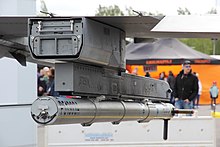AN/ALE-50 towed decoy system
This article has multiple issues. Please help or discuss these issues on the talk page. (Learn how and when to remove these template messages)
|

The AN/ALE-50 towed decoy system is an electronic countermeasure tool designed by Raytheon to protect multiple US military aircraft from air to air and surface-to-air radar-guided missiles.[1] The AN/ALE-50 towed decoy system is an anti-missile countermeasures decoy system used on U.S. Air Force, Navy, and Marine Corps aircraft, and by certain non-United States air forces. The system is manufactured by Raytheon Space and Airborne Systems at its facility in Goleta, California. The ALE-50 system consists of a launcher and launch controller installed on the aircraft (usually on a wing pylon), and one or more expendable towed decoys. Each decoy is delivered in a sealed canister and has a ten-year shelf life.[2]
When deployed, the decoy is towed behind the host aircraft, protecting the aircraft and its crew against RF-guided missiles by luring the missile toward the decoy and away from the intended target. This is done through the mounted control unit sending in both flight tests and actual combat, the ALE-50 has successfully countered numerous live firings of both surface-to-air and air-to-air missiles. U.S. military pilots have nicknamed the decoy "Little Buddy".[3] The system requires no threat specific software, and communicates its health and status to the aircraft over a standard data bus. [4]
Operational History[]
The ALE-50 was first deployed in 1995, but is also used on the F/A-18E/F Super Hornet and the B-1B Lancer.[5] The ALE-50 has also been integrated into the next-generation ALQ-184(V)9 ECM pod, creating an integrated threat-protection system that can be carried on a larger number of platforms.
The ALE-50 expendable decoys' estimated value is $22,000 each. A production run of 1,048 units were delivered through October 2010.[3] An additional 226 units of ALE-50 Bravo T3F launchers were produced for U.S. Navy F/A-18 E/F aircraft in September 2014.[6]
The ALE-50 towed decoy has provided combat-proven aircraft protection against RF missile threats in Kosovo, Afghanistan, and Iraq.[7][8] Featuring low acquisition and life-cycle cost, the system adaptability enables installation and operation on virtually any airborne platform. The ALE-50 towed decoy is currently operational on the F-16, F/A-18E/F, and B-1B aircraft with more than 25,000 deliveries.[7][9]
References[]
- ^ "Raytheon repairs towed decoys for Super Hornets". . 8 December 2021. Archived from the original on 8 December 2021. Retrieved 3 January 2022.
- ^ Colman, Ron (2001). "AN/ALE-50 Towed Decoy System". . Archived from the original on 3 January 2022. Retrieved 3 January 2022.
- ^ a b Defense Industry Daily Article
- ^ A.K., Trikha (March 2012). "Electronic Warfare - Countering Missile Threats". . Archived from the original on 8 January 2022. Retrieved 8 January 2022.
- ^ "Contracts". US Department of Defense. 22 April 2020. Archived from the original on 3 January 2022. Retrieved 3 January 2022.
- ^ "Local Navy Contract Awards". . 25 September 2014. Archived from the original on 8 January 2022. Retrieved 8 January 2022.
- ^ a b Raytheon Product Information Page
- ^ Rogoway, Tyler (28 March 2019). "F-35's Most Sinister Capability Are Towed Decoys That Unreel From Inside Its Stealthy Skin". The Drive. Archived from the original on 8 March 2021. Retrieved 3 January 2022.
- ^ Keller, John (14 June 2019). "Raytheon to demonstrate electronic warfare (EW) towed decoy aircraft protection from radar-guided missiles". . Archived from the original on 3 January 2022. Retrieved 3 January 2022.
- Electronic countermeasures
- Electronic warfare equipment
- Military electronics of the United States
- Equipment of the United States Air Force
- Military technology
- Raytheon Company products
- Towed decoys
- Weapons countermeasures
- Military equipment introduced in the 1990s
- Military aviation stubs